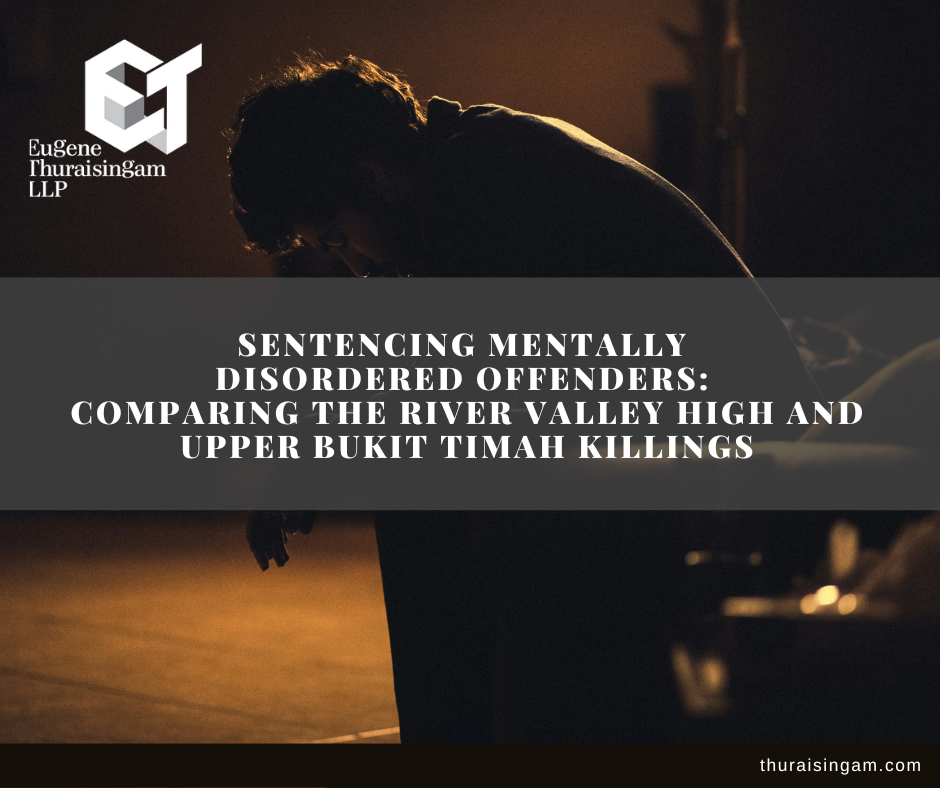Sentencing Mentally Disordered Offenders: Comparing the River Valley High and Upper Bukit Timah Killings
Introduction
Under Section 304(a) of the Penal Code, which punishes a person who commits culpable homicide not amounting to murder, a judge has a range of sentencing options – caning, jail term of up to 20 years, and life imprisonment. A father kills his two autistic sons,[1] a schoolboy kills his schoolmate,[2] and both the schoolboy and the father plead guilty, saying that they suffered from depression at the time of their offences. How should a judge sentence these persons?
This was the issue facing the Courts in two cases – Public Prosecutor v Yap Jung Houn Xavier [2023] SGHC 224 (“Xavier Yap”)[3] and Public Prosecutor v CNK [2023] SGHC 358 (“CNK”)[4].
While the profiles, motivations and backgrounds behind the killings diverge significantly, they serve as an interesting comparison since both offenders received similar sentences – 14 years for the father and 16 years for the schoolboy – in judgments issued by the High Court dated 15 August 2023 and 28 December 2023 respectively.[5]
Preliminary – the maximum punishment that can be meted out is influenced by the exercise of prosecutorial discretion
Before a judge decides on a sentence, it is important to first note that the maximum punishment he can mete out is influenced by what an offender is charged with, which is subject to the Prosecution / Attorney-General’s Chambers (“AGC”)’s prosecutorial discretion.
This is because there are different charges that might apply to the same act, each attracting different punishment. For instance, if Person A kills Person B, the Prosecution may charge Person A under either Section 299 (Culpable homicide not amounting to murder) or Section 300 (Murder) of the Penal Code. The main difference is that the punishment for murder is either the death penalty or life imprisonment, while there is a range of punishment for culpable homicide not amounting to murder, such as imprisonment and/or caning, and does not include the death penalty.
Both Xavier Yap and CNK were charged under section 299 of the Penal Code by the Prosecution and therefore faced a maximum sentence of life imprisonment.
Key sentencing facts
Here are the key facts relevant to the sentencing of Xavier Yap and CNK.
| Xavier Yap | CNK | |
| Act | Strangled his two 11-year-old sons near a playground
| Killed a 13-year-old schoolmate with an axe in school |
| Background | Sons diagnosed with Autism Spectrum Disorder and Global Developmental Delay.
Wanted to alleviate sons’ pain and suffering and caregiving burdens of wife.
Wanted to take his own life after taking the lives of his sons. | Planned to commit “suicide by cop”, which would involve killing more than one individual in a killing spree to give the police no choice but to shoot him to death |
| Offence | 2 charges of culpable homicide not amounting to murder | 1 charge of culpable homicide not amounting to murder |
| Maximum sentence under section 304(a) of the Penal Code | (i) imprisonment for life, and shall also be liable to caning; or (ii) imprisonment for a term which may extend to 20 years, and shall also be liable to fine or to caning | |
| Sentence meted out by the Court | 7 years per charge to run consecutively i.e. 14 years’ imprisonment | 16 years’ imprisonment |
| Aggravating factors | 1. The victims were particularly vulnerable. One of the sons stood quietly as his brother was being strangled by his father. 2. The Accused had betrayed the deep trust which had been reposed in him as a parent. 3. The offences were premeditated. | 1. The victim was vulnerable in age, build, and from being isolated and ambushed in the toilet. 2. There was a significant degree of premeditation and planning for about four months. 3. Vicious manner of the attack (with the use of a sharpened axe to forcefully inflict multiple incised wounds on the deceased). 4. Wider-felt impact of triggering unease in the general public due to the act being committed on school grounds |
| Mitigating factors | 1. The Accused’s major depressive disorder (“MDD”) 2. The Accused’s plea of guilt 3. (Not a mitigating factor) The Court disagreed that the Accused had fully cooperated with the Police. The Accused had lied to the Police that he was attacked, hoping that lying to the Police would lead to him receiving a harsher sentence of the death penalty. 4. (Not a mitigating factor) The Court did not see the relevance of the fact that the Accused has a mother aged 80 years old whom he needs to take care of. | 1. The Accused’s MDD 2. The Accused’s young age 3. The Accused’s plea of guilt |
| Major Depressive Disorder | Moderate severity (a) The Accused had the typical symptoms of MDD for the past three years which had worsened in the months prior to the offences, including suicidal and homicidal thoughts. (b) His MDD was of such severity and persistence that it impaired his judgment of the nature and wrongfulness of the offences. (c) He was not of unsound mind at the time of the offences and was fit to plead. (d) He knew killing was wrong. (e) He felt hopeless about the future of the Victims and wanted to kill them to relieve them of their suffering. He also felt that killing the Victims and himself would allow Anna and her daughter, who was not his biological daughter, to be able to carry on with their lives. (f) His risk of reoffending was low as he was employed, had no prior antecedents, and did not have a history of substance abuse. | Moderate severity (a) The Accused had MDD for about six months prior to the killing. The Accused wrestled with ambivalence for months. He visited a webpage titled “Suicidal Ideation: Symptoms, Diagnosis, Treatment, Coping”. Insufficient evidence that the Accused was suffering from psychopathy. (b) The Accused’s MDD played a sufficiently significant role at the time of killing to warrant a charge of culpable homicide rather than murder. (c) The Accused retained control over his actions, and understood that what he was doing was morally and legally wrong. (d) The Accused exhibited a chilling degree of premeditation and cold logic in planning and preparing for the killing. (e) The Accused’s MDD was but one of three major factors which contributed to the killing, the other two being his refusal to get external help and his consumption of snuff videos (depicting actual scenes of human death). The Accused had a supportive family but he rejected their help. |
| Sentencing considerations | The Accused was an offender who had temporary and situational mental disorders and retained his understanding of his actions and could reason and weigh the consequences.[6] The offences committed by the Accused were particularly heinous and serious. The fact that the offender suffered from a serious mental disorder at the time of the offence does not shift away from the need for the retributive and protective principles of sentencing to prevail over the principle of rehabilitation.[7]The court decided that deterrence and retribution should feature as the primary sentencing considerations.[8] | The Prosecution accepted the mitigating factors of the Accused’s MDD, his youth and plea of guilt. The Defence accepted the seriousness and gravity of the offence. The divergence between the Prosecution and the Defence arose largely over the appropriate mitigating weight to be attributed to the mitigating factors, particularly the accused’s mental condition, and whether the dominant sentencing principle ought to be rehabilitation, or retribution and deterrence.[9] The Prosecution and the Defence agreed that this was not a case justifying a life sentence as the evidence did not show that the Accused is a long-term threat to society.[10] They also agreed that caning would not be necessary.[11] The court decided that the case was one so serious and heinous that deterrence and retribution must prevail over the principle of rehabilitation, even though the accused is a young offender and he was labouring under a serious mental disorder. [12] |
The four (competing) sentencing considerations
The four pillars of criminal sentencing are retribution (punishing the offender according to his culpability and seriousness of the crime committed), deterrence (discouraging both the offender and the general public from engaging in similar behaviour), prevention (to lock the offender away so he cannot cause further harm) and rehabilitation (whether the offender is capable of reform), to ultimately arrive at a fair and proportionate punishment.[13]
The weighing of sentencing considerations is influenced by balancing the aggravating and mitigating factors in the case i.e. factors that make an offender more or less culpable for his actions.
Aggravating factors indicate the level of gravity of the crime in specific relation to the offence upon which the accused was charged. Aggravating factors look at aspects such as (1) the degree of seriousness of the offence, (2) the manner and mode in which it was committed, (3) the degree of seriousness of the consequences of the criminal act, and (4) the interests of the public.[14] In both Xavier Yap and CNK’s cases, there were the aggravating factors of the vulnerability of the victim and the premeditation of the act.
Mitigating factors are factors which make a person less culpable for his actions. There are broadly three kinds of mitigating circumstances in law: (a) where the offender’s culpability is not as great as the nature of the offence suggested; (b) where the offender has behaved in a meritorious way which, though it affects neither his culpability nor his sensitivity to the penalty, should count in his favour; and (c) where the offender is fully culpable but will suffer more than most offenders would from the normal penalty.[15]
In Xavier Yap and CNK’s cases, they both suffered from depression and pleaded guilty. And in CNK’s case, the fact that he was a young offender was relevant.
Reasonable people may disagree on what is a fair sentence
There may sometimes be tension amongst the sentencing principles of retribution, deterrence, rehabilitation and prevention, because we may each value different things and empathise differently with the people involved in a crime.
For Xavier Yap, some might feel pity for him because he, as a father of two autistic children, is helpless and would face a lot of stress taking care of his children, while lacking social support due to his family circumstances.
One might also question: why did Xavier Yap kill his two sons through strangulation, and not a simpler and painless method such as poisoning? Wouldn’t Xavier Yap be aware, as he was killing one of his sons, that the other son was observing him and understood what was going on? Essentially, what were his reasons for choosing this method of killing, and might these reasons make one more or less sympathetic to him?
For CNK, the tragedy of the situation arises from the fact that it involves two school-going children, the violence of the entire act in a school, and the impact on the children’s families.
At the same time, one might look at the fact that CNK was a bright student, had a supportive family who offered him therapy and yet this killing happened. One might then question what it is about the legal system and society that produces such outcomes.
Lastly, it is of interest to note that when they committed the offences, both Xavier Yap and CNK had intended to die through the death penalty and a police confrontation respectively.[16] As highlighted above, they were both suffering from Major Depressive Disorder with moderate severity. The sentence meted out by the Court took this into account, with the effect that the eventual punishment was far short of the ultimate penalty.
Conclusion
As can be seen, sentencing is a multi-factorial task with no one answer. Each case is unique on its own facts and requires its own tailored approach and care in treatment.
Disclaimer: This article is not to be taken as legal advice. Please contact us for any queries.
For examples of past cases handled by our firm, please see footnote below.[17]
[1] Lydia Lam, “The Dad Who Killed His Twin Sons”
[2] Davina Tham, “Teen to plead guilty to killing schoolmate at River Valley High”
<https://www.channelnewsasia.com/singapore/river-valley-high-school-axe-killing-court-3400561>.
[3] Public Prosecutor v Yap Jung Houn Xavier <https://www.elitigation.sg/gd/s/2023_SGHC_224>.
[4] Public Prosecutor v CNK <https://www.elitigation.sg/gd/gd/2023_SGHC_358/>.
[5] For completeness, the decision in Public Prosecutor v CNK [2023] SGHC 358 is presently under appeal.
[6] Public Prosecutor v Yap Jung Houn Xavier [2023] SGHC 224 (“Xavier Yap”) at [42]-[43].
[7] Xavier Yap at [44].
[8] Xavier Yap at [45].
[9] Public Prosecutor v CNK [2023] SGHC 358 (“CNK”) at [17].
[10] CNK at [18].
[11] CNK at [19].
[12] CNK at [38] and [40].
[13] Public Prosecutor v Kwong Kok Hing [2008] 2 SLR(R) 684 at [17]. See also Attorney-General’s Chambers, “Understanding Legal Processes: Sentencing in Singapore” <https://www.agc.gov.sg/docs/default-source/legal-processes/sentencing-in-singapore.pdf>.
[14] Public Prosecutor v Huang Hong Si [2003] 3 SLR(R) 57.
[15] Chew Soo Chun v Public Prosecutor [2016] 2 SLR 78 at [32].
[16] Xavier Yap at [18]; CNK at [2].
[17] With regard to murder, see “Criminal Defence Lawyers Secured Acquittal For A Murder Charge” <https://thuraisingam.com/news-mentions/criminal-defence-lawyers-secured-acquittal-for-a-murder-charge>. With regard to mentally-disordered criminal offenders, see “High Court Reduces Sentence Of Knife-Wielding Man Shot In Clementi” <https://thuraisingam.com/case/eugene-thuraisingam-llp-successful-in-appeal-high-court-reduces-sentence-of-knife-wielding-man-shot-in-clementi> and “Public Prosecutor V Low Ji Qing [2019] SGHC 174” <https://thuraisingam.com/case/public-prosecutor-v-low-ji-qing-2019-sghc-174>.






